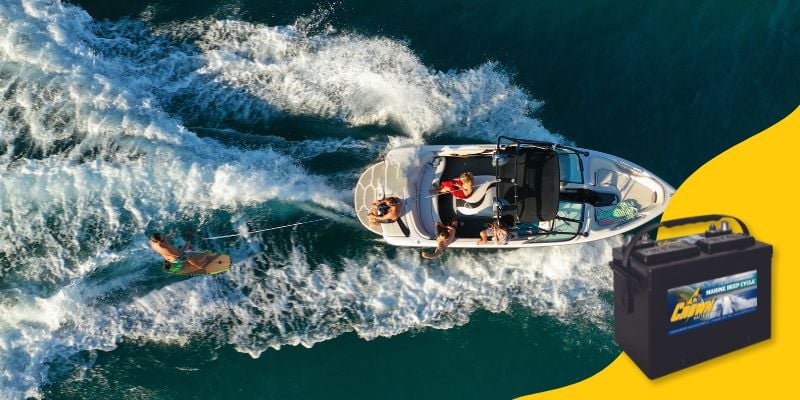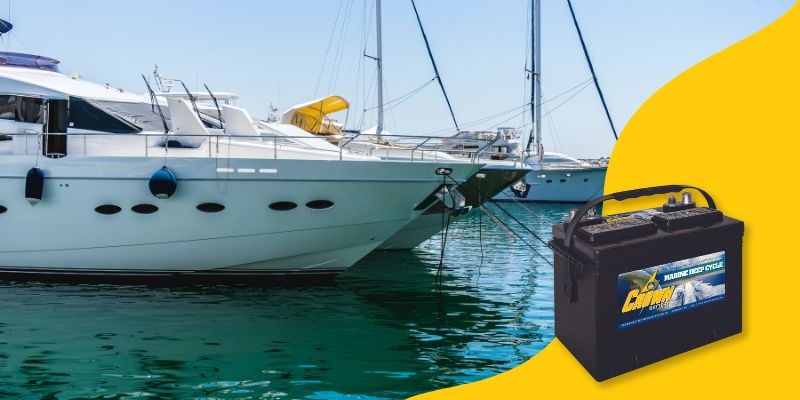Your batteries turn your starter motor and run your GPS, radio, and fish finder. But chances are, they've been lying unused since you winterized your boat. So how do you de-winterize your batteries and ensure they deliver maximum performance and service life?
Here are the steps you can follow for your boat batteries to be ready for the following season:
STEP 1: CONSULT YOUR BOAT OWNER'S MANUAL
The boat owner's manual is the best source of information on the specific battery installed in your boat. The manual will provide information on the battery's type, size, voltage, and amp-hour rating. It will also tell you how to charge and maintain the battery correctly and how to troubleshoot any problems that may occur.
Here are some additional tips for consulting your boat owner's manual:
- Read the manual carefully before you start working on your boat's battery.
- Make sure that you understand the instructions before you proceed.
- If you are unsure about something, feel free to ask for help from a qualified mechanic.
STEP 2: TOP OFF BATTERY CELLS WITH PURIFIED WATER-FLOODED
LEAD BATTERIES ONLY
Ensure that the battery plates are covered by distilled or deionized water. Filling the batteries too high before charging could result in an overflow. Do not use tap water; trace minerals can harm battery plates.
Before you start topping off the battery, also keep in mind these tips:
- Consult your boat owner's manual to determine the correct type and amount of water.
- Wear glasses and protective clothing to protect yourself from battery acid.
- Remove the caps from the battery cells.
- Use a clean, plastic container to measure the correct amount of distilled water.
- Carefully pour the distilled water into each cell until the electrolyte level is above the plates.
- Replace the caps on the battery cells.
STEP 3: SAFETY PRECAUTIONS
Before cleaning batteries, it is essential to take the following safety precautions:
- Wear protective glasses, gloves, and old clothes (including a long-sleeve shirt).
- Keep rinsing water nearby in case of spills.
- Take off all jewelry, watches, etc., and remove electronics.
Following these safety precautions can help prevent accidents and injuries when cleaning batteries.
STEP 4: CLEAN BATTERY COMPONENTS
To ensure optimal performance and prevent corrosion, follow these recommendations:
- Clean battery terminals, cable terminals, and a case with a baking soda paste and a terminal brush. This neutralizes acid and prevents conductivity between the terminals.
- Once connections are made, coat battery terminals with insulating, non-conductive grease or spray-on protective film. (This helps prevent performance-sapping corrosion.)
STEP 5: MEASURE THE VOLTAGE BETWEEN BATTERY TERMINALS
Batteries are an essential part of many devices, and it is vital to measure their voltage to ensure that they are functioning correctly. We recommend following these tips:
- Using a digital voltmeter, measure the battery's voltage. It should read 12.8V (no lower than 11.9V).
- If you've just charged your batteries, wait several hours before measuring voltage. (In a pinch, briefly apply a load to remove some surface charges.)
- Consider adding this testing to your regular maintenance routine. Because when bad batteries receive current from good ones, they lower the state of charge and lifespan for good batteries.
Note: Since a voltmeter measures the overall state of charge, you'll need a hydrometer to determine whether individual cells are fully charged. When using a hydrometer, top off and charge batteries before taking measurements. To prevent inaccurate readings: test at ~70°F or use a temperature-compensating hydrometer.
STEP 6: CHARGE BATTERIES FULLY
You will need a battery charger compatible with your battery type and size to charge your marine batteries fully. (Avoid using old-fashioned manual chargers.)
If you're looking for a new battery this season, a CROWN1™ Maintenance-free Severe Duty AGM model is the right choice. These batteries are precision engineered and built to work hard for boat owners who refuse to compromise. They feature:
- Super-thick SolidCast™ plate construction, more Active Material, and premium Glass Mat Separator for superior performance and longevity.
- Certified non-spillable, sealed, and maintenance-free.
- Safe, sustainable, and ultra-clean with no gassing.
- Available in BCI Group 24 and 31 sizes.
- Proudly made in the USA.
With a CROWN1™ AGM Marine Battery, you can enjoy carefree days on the water knowing that your batteries deliver maximum performance and service life.
13.4 VOLTS FOR FLOODED, 13 VOLTS FOR AGM BATTERIES
Smart chargers offer numerous benefits over conventional chargers. Here are a few:
- Deliver an optimal charge every time.
- Prevent overcharging and overheating – common in older chargers – that shorten the lifespan.
- Equalize or "float" batteries – that is, deliver a low-level charge to balance cells.
- Whatever charger you use, run a complete cycle, then measure their voltage again—top off flooded batteries with distilled or deionized water.
- If possible, keep batteries fully charged between uses and during the off-season. This minimizes self-discharge and sulfation (which reduces chemical reactions necessary for energy storage and cuts lifespan). Otherwise, charge batteries at least once every month, including off-season.
STEP 7: REINSTALL BATTERIES AS NEEDED
HOW TO KEEP YOUR BOAT BATTERIES SAFE AND SECURE
- Record your installation date on the battery with a grease pencil or in a logbook.
- Tie-down batteries tightly using a battery box or bracket. (Double-check to confirm it meets American Boat and Yacht Council specifications.)
- Crimp terminals tightly, then cover them with heat-shrink tubing.
- Ensure the positive terminal is covered. Many retailers sell inexpensive "boots" that prevent arcing, sparks, and other hazards from objects like tools falling on batteries.
- Swap out wingnuts for stainless steel lock nuts to ensure tight connections and maximum performance.
IF YOUR BATTERIES AREN'T OPERATING PROPERLY OR WON'T HOLD A CHARGE:
- Flooded batteries: Measure each cell with a hydrometer. Cells in a fully charged battery should read between 1.230 – 1.300, depending on temperature. Any difference greater than 0.050 could indicate a faulty cell.
- You can rent or borrow a load-testing device or other equipment to determine your battery's health.
- Your battery vendor or an electrician will have additional tools and can help diagnose battery problems.
IF YOUR BATTERY IS DAMAGED AND CAN NOT BE EQUALIZED BACK TO REGULAR OPERATION:
- Make sure it's recycled (lead batteries are 99% recyclable —more recyclable than an aluminum can).
- Always buy replacement batteries in matching styles and sizes.
Finally, consult North American Clean Energy's article "5 Things to Look For In Your Next Battery" to ensure you select the correct battery for your boat.












